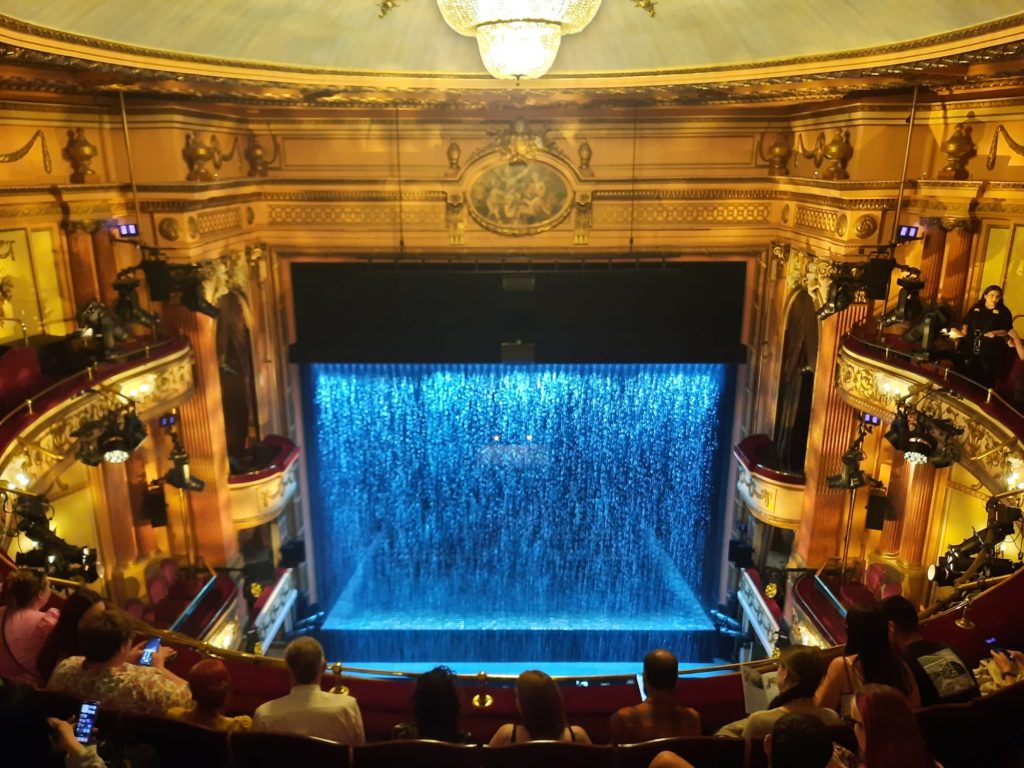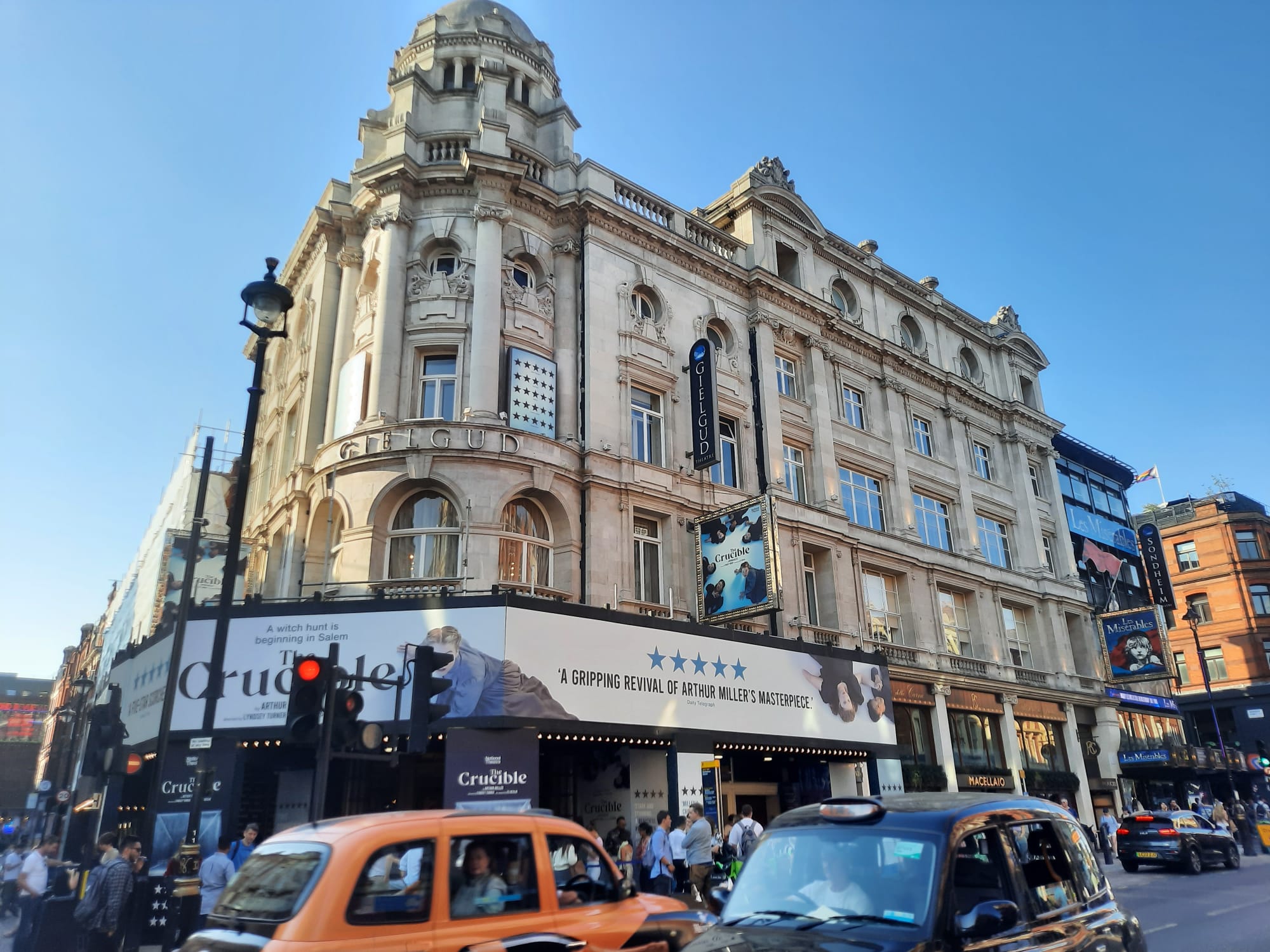The Crucible – National Theatre / Gielgud Theatre, London
Some seventy years after its first production, The Crucible still has the power to illuminate aspects of human nature.

The Crucible
Thank goodness for West End transfers – I love a second chance. The Urban Geographer and I ran out of time to see The Crucible at the National Theatre last year, so were pleased to see it had transferred to the Gielgud Theatre. Lyndsey Turner‘s production got great reviews in its original run, and some key cast members have returned for its West End run.
Many readers will know The Crucible. As far as I recall this is the first time I’ve seen it on stage, but I studied it at some point in my academic career and so was familiar with the story. Famously, The Crucible is an allegory. By writing about the 17th Century Salem Witch Trials, Arthur Miller was able to explore McCarthyism: the chasing after spectres, the playing out of old grudges, the difficult choices for individuals asked to betray themselves or others in order to keep their good name or their live(lihood)s.
In what is actually quite a refreshing twist, Turner’s version of The Crucible plays it straight. There’s a bit of fancy set design, sure. But otherwise it’s in traditional costume, no reinterpretation, no bells and whistles. Just good, honest, New England witch hunting. This doesn’t prevent us from thinking about the play’s relevance today – more on this later. But it does change how we go about this.
Just Good, Honest, New England Witch Hunting
Obviously I didn’t see the original National Theatre cast. But the cast I did see was uniformly strong, and I would not have made any substitutions given the chance. The key relationship in The Crucible is that between farmer John Proctor and Abigail Williams, formerly his servant – and more. Hell hath no fury like a woman scorned and all that, and Williams’ feelings towards her former lover and his wife have a lot to do with how the witchcraft accusations develop. Interestingly both characters are real in the sense that people by those names were involved in the Salem Witch Trials. The real Proctor even dismissed the girls’ actions as fakery. But Miller added a few years to Williams’ age and invented their relationship and a few other details.
In this production, Brian Gleeson is a fine John Proctor. He is like a lynch pin on which the rest of the play hangs, a flawed hero all too aware of his faults. Opposite him is Milly Alcock as Abigail. Having myself once been a teenage girl, her growing confidence and ruthlessness as she realises her power over others is all too believable (although I should state for the record that neither I nor any teenage girls of my acquaintance ever accused anyone of making compacts with the Devil).
The remainder of the cast is similarly strong. We feel for Nadine Higgin as Tituba as she quickly folds and ‘confesses’ to save herself: an easy target due to her social standing and Barbadian origins. Fisayo Akinade as Reverend John Hale crumbles before our eyes: from naive confidence in the books he has read to a man broken by his part in the miscarriage of justice. Nia Towle as Mary Warren wavers like a flickering candle, her newfound strength insufficient in the face of Abigail’s manipulative and malicious visions. Between the quality of the acting and the relentless pressure applied by Turner’s direction, the more static second half does not drag but rushes towards its conclusion.
Designing A Witch Hunt
From what I’ve read, most elements of the design are the same as at the National Theatre. Es Devlin has designed the set. The sloping perspective was a little hard to see from my seat up in the Grand Circle (cheap seats), but adds to the feeling of pressure, the impossibility of escape. A curtain of rain at the front of the stage is an impressive touch, but is more a feature as the audience arrives and during the interval. Is it more gimmick than additive? All I will say is that on-stage rain seems to be de rigeur. I far preferred the honest simplicity of the rest of the set to this flourish, however imposing.
The lighting, by Tim Lutkin, was in my opinion very effective. As well as recreating candle-lit buildings rather effectively, Lutkin uses darkness well for its oppressive power. Like a person speaking softly so that you lean in to listen, the mellow lighting pulled me into the world of the story.
And I must save a few words for Catherine Fay’s costume design. It is a stroke of genius to have all the girls in soft rosy shades, save Abigail. Her green dress sets her apart: the stem from which the blooms draw their strength. The girls’ costumes also give their hysteria an unnatural edge, menacing despite (or because of) the innocence of their dress.
Room For Interpretation
What is the purpose, then, of restaging The Crucible now? And of doing it so simply? I would like to think that this choice is based both on the strength of the material and the director’s trust in the audience. Because this is the sort of play that’s always going to tell us something. Miller gave us an allegory that applied to what was happening in his own time. But hysteria, fundamentalism, and questions of how far one will debase themselves to avoid ruin, are not unique to America in the 1690s or 1950s. Rather than telling us what this new interpretation should be, however, Turner leaves it to us to think through.
One thing I found myself pondering was the way that it’s always a slippery slope. ‘They’, whoever they are (witch hunters, fascists, etc.) will come first for the weak. In The Crucible, the girls test the waters with Tituba and other outsiders. This quickly snowballs into other women in the community, and then the men. How confident is anyone that the erosion of protections we’re seeing (of trans people, of women) will stop before it reaches their own doorstep? This production is a slow burn for me mentally, so I am certain more insights will come my way over time.
To leave you with a final thought, it’s not long ago I saw another play about McCarthyism. Retrograde, at the Kiln Theatre, explored an incident from Sidney Poitier’s early career. Poitier, on the verge of his big break, had to decide whether to grasp fame by betraying a friend. Time will tell whether this more recent play is as timeless. But the pairing of the two in quick succession revealed to me just how close The Crucible was to reality. The ‘confession’ to save one’s skin. The turning in of a bigger fish to the same end. The paranoia, jealousy and betrayal. Really quite remarkable that all this played out in 1950s Hollywood as it did in 1690s Massachusetts.
Salterton Arts Review’s rating: 4/5
The Crucible on until 2 September 2023
Trending
If you see this after your page is loaded completely, leafletJS files are missing.

